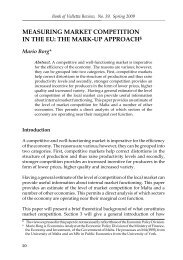Market Gaps on Access to Finance - Bank of Valletta
Market Gaps on Access to Finance - Bank of Valletta
Market Gaps on Access to Finance - Bank of Valletta
You also want an ePaper? Increase the reach of your titles
YUMPU automatically turns print PDFs into web optimized ePapers that Google loves.
Malta Business Bureau – <str<strong>on</strong>g>Market</str<strong>on</strong>g> gaps in access <strong>to</strong> finance<br />
April 2013<br />
One <strong>of</strong> the main shortcomings observed in the previous programming period were related <strong>to</strong> gap<br />
assessments 84 . Financial instruments are a special category <strong>of</strong> spending and their successful design<br />
and implementati<strong>on</strong> hinges <strong>on</strong> a correct assessment <strong>of</strong> market gaps and needs. The amended<br />
regulati<strong>on</strong>s stipulate that financial instruments should be designed <strong>on</strong> the basis <strong>of</strong> an ex ante<br />
assessment that has identified market failures or sub-optimal investment situati<strong>on</strong>s, respective<br />
investment needs, possible private sec<strong>to</strong>r participati<strong>on</strong> and resulting added value <strong>of</strong> the financial<br />
instrument in questi<strong>on</strong>. Such an ex ante assessment should also avoid overlaps and inc<strong>on</strong>sistencies<br />
between funding instruments implemented by different ac<strong>to</strong>rs at different levels.<br />
The EC has already outlined a number <strong>of</strong> proposals for the inclusi<strong>on</strong> <strong>of</strong> innovative financial<br />
instruments in the next MFF <strong>to</strong> be implemented through a set <strong>of</strong> comm<strong>on</strong> rules and guidance for<br />
equity and debt instruments (referred <strong>to</strong> as the “EU equity and debt platforms”) 85 . These include 86 :<br />
BOX 3.5.4.1: Investments in RD&I under Horiz<strong>on</strong> 2020<br />
Two financial instruments are planned:<br />
(1) a debt instrument providing loans <strong>to</strong> single beneficiaries for investment in RD&I,<br />
guarantees <strong>to</strong> financial intermediaries making loans <strong>to</strong> beneficiaries, combinati<strong>on</strong>s<br />
<strong>of</strong> loans and guarantees and/or counter-guarantees for nati<strong>on</strong>al or regi<strong>on</strong>al debtfinancing<br />
schemes, and<br />
(2) an equity instrument that would (i) invest in technology transfer and intellectual<br />
property vehicles and in venture capital funds providing equity finance <strong>to</strong> early stage<br />
RD&I-intensive SMEs, and (ii) support investments in RD&I sec<strong>to</strong>rs by targeting<br />
thematically focused, multi-country “funds-<strong>of</strong>-funds” with a broad inves<strong>to</strong>r base,<br />
including private instituti<strong>on</strong>al and strategic inves<strong>to</strong>rs.<br />
BOX 3.5.4.2: Competitiveness and SMEs<br />
Two financial instruments <strong>to</strong> be funded by the Programme for the Competitiveness <strong>of</strong><br />
Enterprises and SMEs 2014-2020 (COSME) are being proposed:<br />
(1) an equity facility for growth-phase investment, which will provide commercially<br />
oriented reimbursable equity financing primarily in the form <strong>of</strong> VC through financial<br />
intermediaries <strong>to</strong> SMEs. Two measures are envisaged:<br />
- Direct investments in VC funds which operate across borders within the EU and<br />
are focused <strong>on</strong> investing in growth-oriented enterprises not primarily based <strong>on</strong><br />
innovati<strong>on</strong> or research.<br />
- “Funds-<strong>of</strong>-funds” investing across borders in VC funds which subsequently<br />
invest in enterprises, in particular in their internati<strong>on</strong>al expansi<strong>on</strong> phase.<br />
(2) a loan facility, providing direct or other risk sharing arrangements with financial<br />
intermediaries <strong>to</strong> cover loans for SMEs and provide cross-border lending or multicountry<br />
lending with a high leverage effect.<br />
84 This was <strong>on</strong>e <strong>of</strong> the main recommendati<strong>on</strong>s put forward by the Court <strong>of</strong> Audi<strong>to</strong>rs’ report, also suggesting the inclusi<strong>on</strong> <strong>of</strong><br />
a quantified analysis <strong>of</strong> the financing gap (European Court <strong>of</strong> Audi<strong>to</strong>rs (2012), Financial instruments for SMEs – audit report).<br />
The same report also provides a good practice example <strong>of</strong> a gap assessment related <strong>to</strong> an initiative in Sweden (Ibid, pg. 18)<br />
85 Various documents highlight the need for amendments <strong>to</strong> the Regulati<strong>on</strong>s, improved guidance and technical assistance <strong>to</strong><br />
be provided <strong>to</strong> Member States <strong>on</strong> the basis <strong>of</strong> experiences from the 2007-2013 Programming Period (European Court <strong>of</strong><br />
Audi<strong>to</strong>rs (2012), Financial instruments for SMEs – audit report; European Commissi<strong>on</strong> (2012), Financial Instruments in<br />
Cohesi<strong>on</strong> Policy; European Commissi<strong>on</strong> (2011), A framework for the next generati<strong>on</strong> <strong>of</strong> innovative financial instruments – the<br />
EU equity and debt platforms). This need for higher assurance will, however, come at the price <strong>of</strong> flexibility.<br />
86 European Commissi<strong>on</strong> (2011), A framework for the next generati<strong>on</strong> <strong>of</strong> innovative financial instruments – the EU equity<br />
and debt platforms, pgs. 11-12<br />
Page | 38







